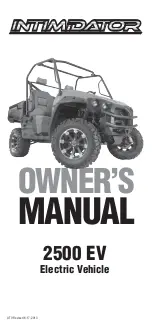
40
MAINTENANCE
Read all of SAFETY and this section before attempting any procedure. Pay particular attention to Notices, Cautions, Warnings and Dangers.
Owner’s Guide
Battery
A battery is described as two dissimilar metals immersed in an acid. If the acid is absent or if the metals are not dissimi-
lar, a battery has not been created. The batteries in this vehicle are lead acid.
A battery does not store electricity, but it can produce electricity as the result of a chemical reaction which releases stored
chemical energy in the form of electrical energy. The chemical reaction occurs faster in warm conditions and slower in
cold conditions. Temperature is important when conducting tests on a battery and test results must be corrected to adjust
for temperature differences.
An older battery can perform adequately except that its capacity is decreased. Capacity describes the time that a battery
can continue to supply its design amperes from a full charge.
A battery has a maximum life. Good maintenance maximizes the available life and decreases the conditions that can
reduce the life of the battery.
Battery Maintenance
Tool List
Quantity
Tool List
Quantity
Insulated Wrench, 9/16" .............................................. 1
Battery Carrier............................................................. 1
Hydrometer.................................................................. 1
Battery Maintenance Kit P/N 25587-G01 .................... 1
Battery Protective Spray.............................................. 1
Socket, 9/16” ............................................................... 1
Torque Wrench ............................................................ 1
At Each Charging Cycle
•
Before you charge the batteries, inspect the plug of the battery charger and vehicle receptacle housing for dirt or
other particles.
•
Charge the batteries after each use.
Monthly
•
Inspect all wires for wear, loose connections, corrosion or damage of insulation.
•
Make sure that the electrolyte level is correct and add clean water as required.
•
Clean the batteries and wire connections.
•
Apply battery protectant to the battery terminals.
Electrolyte Level and Water
The correct level of the electrolyte is 1/2" (13 mm) above the plates in each cell.
This level will leave approximately 1/4" - 3/8" (6 - 10 mm) of space between the electrolyte and the vent tube.
The electrolyte level is important because any part of the plates open to air will be damaged.
Do not overfill with water. Too much water pushes the electrolyte from the battery by release of gas and a decrease in
volume of the electrolyte.
DO NOT overfill batteries. The charge cycle will expel electrolyte and cause component damage.





























